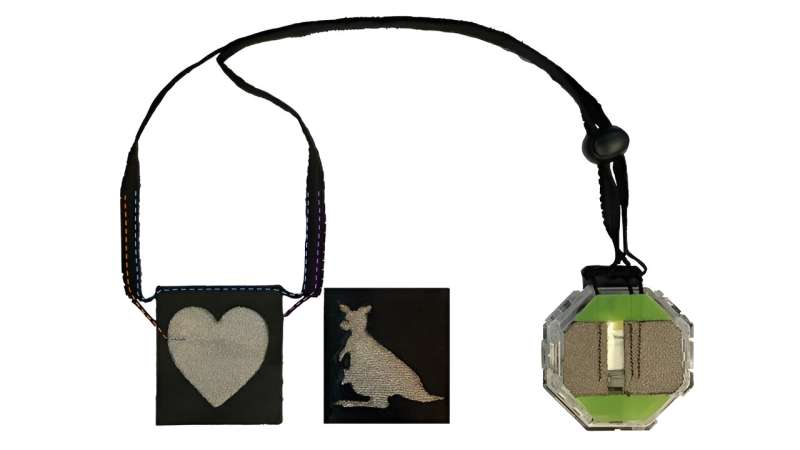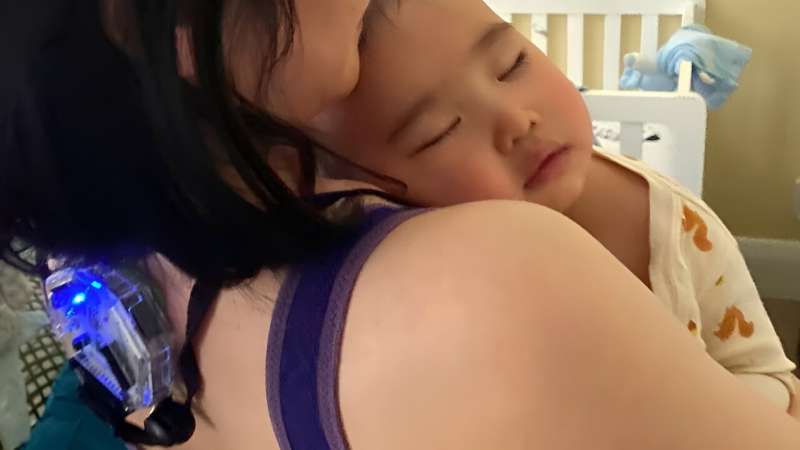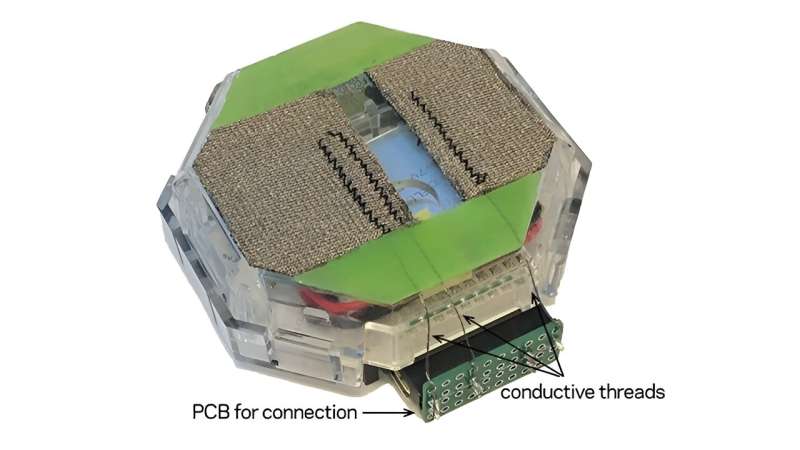This article has been reviewed according to Science X's editorial process and policies. Editors have highlighted the following attributes while ensuring the content's credibility:
fact-checked
trusted source
proofread
Soft fabric necklace monitors care of preterm, low-birth-weight infants

The practice of Kangaroo Mother Care (KMC), which involves chest-to-chest skin contact between an infant and a caregiver, has been recommended for low-birth-weight (LBW) infants—preterm and full birth—by the World Health Organization (WHO) since 2003. It has been shown to reduce neonatal mortality by 32% based on WHO's 2023 report and has been adopted as a standard of care for infants with low birth weights worldwide.
Continuous monitoring of KMC is clinically important for several reasons. It's critical to nursing care by enabling early identification of potentially life-threatening issues for infants. It helps caregivers bond with their babies, who, in turn, can improve in all kinds of ways, from increased weight gain to decreased stress levels to earlier discharge from the hospital.
It can be very effective for neonatal care in areas with limited resources. In addition, the duration of KMC sessions and the infant's vital signs during KMC hold significant clinical values, producing data that can advance clinical research on the impact of KMC.
Existing KMC monitoring methods, however, either rely on manual efforts that are cumbersome and prone to errors, or require placing rigid, adhesive sensors, wires, and electrodes on the baby's body, which can cause skin breakdown in hospitalized newborns.
A new, easier way to monitor KMC
A Columbia Engineering team, led by Xia Zhou, associate professor of computer science, decided to see if they could make KMC monitoring easier. An expert in mobile computing and networks, Zhou's research is focused on wireless systems and mobile health.
Her interest was sparked after a conversation with her colleague Fred Jiang, associate professor of electrical engineering at Columbia Engineering, whose team was exploring solutions to KMC monitoring by using microphones. Zhou's group was already studying fabric sensing, so they started to investigate a fabric approach to the problem.
The paper is published as part of the Proceedings of the 22nd Annual International Conference on Mobile Systems, Applications and Services.
They knew that the electrocardiogram (ECG) waveform yields critical clinical metrics that are essential for the diagnosis and management of various cardiac issues and diseases. So they proposed a fabric-based wearable technology for KMC monitoring, and designed Joey as a lightweight, soft fabric necklace worn by the caregiver on her chest skin.
Qijia Shao, Zhou's Ph.D. student and the study's lead author, came up with Joey's elegant design, which continuously monitors the chest-to-chest skin contact duration between the caregiver and an infant, as well as two vital signs essential to an infant's well-being: heart rate and respiration rate. And all without needing to place any sensors on the baby's body.
"Our work is the first study that systematically explores the transmission of electrocardiogram (ECG) signals across human bodies as well as the conditions for sensing mixed ECG signals," Zhou said. "This work extends the application of fabric-based sensing to multi-user scenarios and opens exciting possibilities for new developments in multi-user fabric sensing and interaction."

How Joey works
Joey achieves the team's monitoring goals by exploiting the transmission of ECG signals across individuals during skin-to-skin contact when the sensing path crosses their hearts, using fabric sensors to measure the electrical activity in response to cardiac activity. It can detect the presence of mixed ECG signals of the two bodies in contact to measure the chest-to-chest skin contact duration.
Zhou's team then developed computational algorithms to extract infants' ECG signals for vital sign monitoring and to mitigate the impact of motion to ensure reliable, accurate sensing.
Collaboration with Columbia's neonatal pediatricians
The researchers worked with 35 participants to demonstrate Joey's accuracy in estimating KMC duration with an average accuracy of 96% and vital sign estimations with clinically acceptable accuracy. Interviews with eight pediatricians in the Division of Neonatology at the Columbia University Irving Medical Center (CUIMC) further confirmed the clinical usability of Joey's sensing fabric for infant skin. The system is also robust against various practical factors such as motion noise, repeated washing, and variations in skin conditions.

"I am very excited about our findings because they demonstrate the promising potential of physiological sensing using everyday conductive fabrics, a ubiquitous and natural sensing medium," said Shao. "The comfort and ease of wear of these soft, sensing materials offer a significant advantage over rigid, adhesive sensors, which have been the mainstream methods for physiological sensing."
The study is being presented today by Shao, who is graduating this summer and joining Hong Kong University of Science and Technology as an assistant professor, at the ACM MobiSys 2024 conference in Minato-ku, Tokyo, Japan.
Zhou's team is continuing to work with pediatricians at CUIMC, discussing potential collaboration ideas, including conducting clinical studies of the technology. The group is also exploring other applications of fabric-based physiological sensing, such as sleep monitoring and wearable robotics.
More information: Qijia Shao et al, Joey: Supporting Kangaroo Mother Care with Computational Fabrics, Proceedings of the 22nd Annual International Conference on Mobile Systems, Applications and Services (2024). DOI: 10.1145/3643832.3661867



















